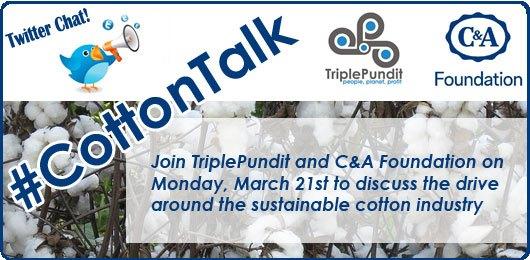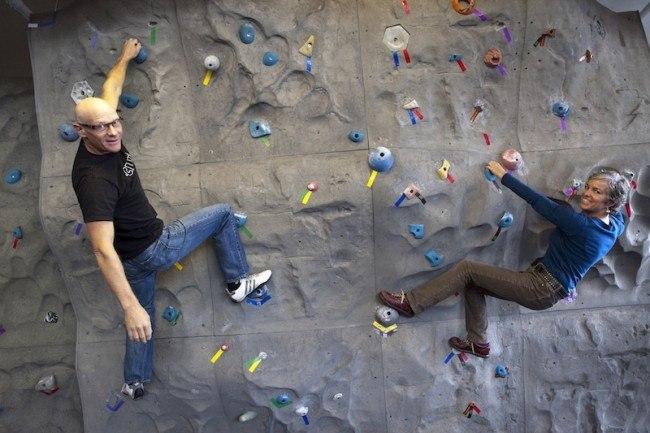Twitter Chat Recap: #CottonTalk w/ C&A Foundation


Today, the C&A Foundation and guest panelists discussed the drive around the sustainable cotton industry, and why it is making a huge difference globally. Providing their thought leadership, Richard Holland (Director, Market Transformation Initiative at WWF), Shona Quinn (Sustainability Leader at Eileen Fisher), and Anita Chester (Head of Sustainable Raw Materials at C&A Foundation) weighed in and shared their experiences.
Cotton is known as “the fabric of our lives,” and it’s true. Chances are you are wearing cotton fibers right now. This cash crop is indispensable to the apparel industry and the economies of entire countries. However, its environmental and social impact can be huge.
Through this conversation, and our currently running editorial series, we are gaining a deeper understanding of this critical crop, understanding methods to reduce its footprint, and learning how to define sustainable cotton now and in the future.
During #CottonTalk, we addressed the following topics, and more:
- Environmental impact of cotton farming and benefits of more sustainable cotton?
- What are the challenges on the market with organic and more sustainable cotton?
- How does buying clothes made from organic or more sustainable cotton make a difference?

FEATURED GUESTS:
- Richard Holland (@RichardDHolland) - Director, Market Transformation Initiative at WWF
- Shona Quinn (@Shona_Quinn) - Sustainability Leader at Eileen Fisher
- Anita Chester (@AnitaChester58) - Head of Sustainable Raw Materials at C&A Foundation
MODERATORS:
- The TriplePundit Team
About C&A Foundation
C&A Foundation is a private foundation, affiliated with the global clothing retailer C&A. C&A Foundation is working to transform the apparel industry into a fair and sustainable industry that respects the rights of workers, improves livelihoods and the conserves the environment. It collaborates with key partners to achieve the best results and greatest long term impact. From farmers to factory workers, C&A Foundation helps build strong and resilient communities in all the countries it touches.
Image credit: NorWood Themes and Marten Bjork via Unsplash
Bolstering Buildings Against the 'Big One'


By Sara Thompson
A massive earthquake is overdue to strike the coast of the Pacific Northwest. Few of the area’s cities and people are prepared for the devastation that will follow the temblor and subsequent tsunami.
That’s the conclusion of scientists working with the Federal Emergency Management Agency, according to an article published in the July 20, 2015, edition of the New Yorker magazine.
Geologists studying the Cascadia subduction zone say the “big one” has a 1 in 10 chance of striking in the next 50 years. The Cascadia fault begins in Northern California and continues for 700 miles through Oregon and Washington, ending in Canada near Vancouver Island. Portland, Seattle and around 7 million people live in the zone.
The Cascadia subduction zone has been active for thousands of years. It’s responsible for small rumblings and large volcanic eruptions. A subduction zone is the area where one tectonic plate is slowly moving beneath another. When the edges of the plates collide rather than subduct, violent earthquakes follow.
It’s only been in the last few decades that geologists identified the dangers of the Cascadia fault. Most buildings in the zone haven’t been designed with earthquakes in mind. As awareness grows of the eventuality of a big shake-up, some cities are retrofitting buildings and bridges to carry a greater seismic load.
What is seismic rehabilitation?
Older buildings, even those built as recently as the 1990s, often can’t withstand the impact of an earthquake. Some communities now require the seismic rehabilitation of structures.Rehabilitation involves making the materials in walls better able to absorb the swaying caused by earthquakes. Concrete and masonry in older buildings are vulnerable to collapse when earthquakes strike. Retrofitting these materials with such things as steel bars and structural foam adhesive can prevent building failure and save lives.
Which buildings need seismic rehabilitation?
Any building not constructed to withstand seismic loads may require retrofitting. Public buildings such as schools and those that house emergency services are most in need of seismic rehabilitation. Buildings that are important historically are also often retrofitted. Seismic rehabilitation is less expensive than new construction, and in the case of historic buildings, it can preserve the original design and materials of the property.
Is funding available for seismic rehabilitation?
The Seismic Rehabilitation Grant Program of Oregon provides money for the retrofitting of certain public buildings. This program is for structures in public school districts, education service districts, community colleges and universities. Hospitals, fire and police stations, and other first responders’ organizations are also eligible for funding from this program.
FEMA manages programs that offer grants to reduce the hazards posed by natural disasters including earthquakes. The programs include assistance for states in areas with seismic risk. The agency also has agreements with nonprofit organizations, such as the Earthquake Engineering Research Institute, dedicated to earthquake safety. The EERI publishes several resources helpful for those responsible for seismic rehabilitation of buildings.
Image credit: Pixabay
Sara Thompson writes on behalf of Spray-On Foam + Coatings, Inc., a seismic rehabilitation contractor in Vancouver, Washington. Visit www.sprayonfoam.com or follow @sprayonfoam for more info.
Why every business should volunteer


EP Journal
by Mohammed Sharaf, DP World
Businesses are perfectly placed to use their reach to bring about considerable benefits to the communities in which they operate. This is especially true of global businesses who, by acting in the belief of ‘doing good’, can unite a diverse workforce behind a common mission – building a robust organisation, here for the long term.
At DP World, we take our responsibility to sustainability seriously and to deliver on our commitments to our people, our customers and our planet, we rely on the enthusiasm, ideas and skills of all our employees. We are present in more than 35 countries, across six continents, and we encourage every one of our family of 36,000 people to play a part in creating the future we want to see – and for those that come after us.
We have established programmes across the globe supporting issues of social relevance such as improved education, better health and marine protection. We deliver these programmes in a number of ways but volunteering with community partners is still, and always will be, a key way of making this happen.
COMMUNITY
Building on a long established culture of volunteering, we created ‘Global Volunteer Week’, a weeklong focus every December in which we actively encourage everyone to engage with the community and to make a difference. This year was the second time we have run Global Volunteer Week. Some 3,250 volunteer hours were contributed to our local communities, benefitting over 8,400 people. We saw a 30% increase in the number of programmes we delivered and more than doubled the number of people who personally benefited from our efforts.
Examples of programmes undertaken this year included decorating Christmas activity kits for underprivileged children in Argentina, preparing meals for the homeless in Western Australia, helping care for children with disabilities in Dubai and raising awareness of the importance of safe drinking water in an Indian school.
To ensure there is strong uptake with volunteering, we show leadership from the top. We want a culture where doing good is seen as an important part of everyone’s job. I supported a homeless shelter near our London offices, called The Passage. I joined others in preparing meals for those in need and was touched by the enthusiasm of my colleagues and shared with them the positive experience of seeing firsthand the benefit of our contributions.
Global Volunteer Week does not sit as an ‘add on’ to our business, but is central to how and why we do business. It is the culmination of a year-round commitment to our communities – last year, our employee volunteers supported 527 organisations, benefiting more than 64,000 people and our figures for 2015 are set to grow further.
Global Volunteer Week is a great example of a global plan with local action that enables each of our more than 65 business units to consider what will bring the greatest benefit relevant to what they do and where they are, integrating it into what they do on an on-going basis.
Working with our communities in this way not only enriches the quality of life of the people we help, it improves motivation and offers development opportunities for the individuals taking part. We see volunteering as a highly effective way of developing skills and training.
Our volunteering programme has helped us build excellent levels of engagement in our workforce, with 77% saying that “DPW is corporately responsible in the community”. Our annual employees survey also shows high levels of understanding and support for our organisational objectives, which is crucial to getting everyone behind our mission.
Having such a large and diverse workforce – not just geographically but also in job roles – Global Volunteer Week is a perfect way to bring everyone together to feel part of a global family. We share stories of what we are doing around the world through social media, through our intranet and through our website. We make it the focus of coffee breaks and corporate events.
OBLIGATION
We rely on engaged and motivated employees to build a strong business. An engaged workforce attracts the top talent and boosts retention.
It establishes a mutual relationship of trust between a business and the communities in which it operates. Conversely, disengaged employees are one of the biggest threats any business can face.
It can lead to higher turnover, absenteeism and, in a business like ours, could mean people are more likely to take risks or experience accidents.
It should be the obligation of every business of every size in every location to build strong partnerships with their communities and to provide every employee the opportunity to be part of this through in-work volunteering. It is core to being a business that is serious about being sustainable, and doing business for years to come.
Forging a positive future for ethnic diversity in business


EP Journal
by Brian Collett
Black women now comprise the fastest-growing group of entrepreneurs in the US.
A new study from Digitalundivided, a New York-based company whose aim is a pipeline of black entrepreneurs and investors in technology, reports that they run about 1.5 million businesses, 322% more than in 1997, and generate at least $44bn (£30.8bn, €39.4bn) in revenue annually.
Yet, of the 10,238 businesses receiving venture capital between 2012 and 2014, only 24 were headed by black women.
This is the challenge for Monique Woodard, who has just joined the venture capital consultancy 500 Startups in San Francisco as its first African-American partner. Her purpose is to increase investment in black and Latino entrepreneurs, with a particular concentration on technology.
Her pedigree includes a leading role with the Brand Institute, which specialises in branding services. Woodard spearheaded brand development projects for clients that included Avon, Bayer and Starbucks.
Her technology experience involved working with established and startup companies to define strategy, introduce innovative products and highlight them on web, mobile and social media.
Most recently Woodard was a Mayor’s Innovation Fellow for the San Francisco city government, managing technology products for running civic services and heading partnerships for the mayor’s Office of Civic Innovation.
Her commitment to the African-American community is exemplified by her role as a co-creator of Black Founders, a professional body promoting diversity in the technology industry. Black Founders produces networking and educational events in Silicon Valley and elsewhere.
Woodard, whose new appointment coincides with the Digitalundivided report, Project Diane, on black women and business in the US, said: “We have to diversify who’s going out there and finding companies and who’s writing the cheques.
“That is incredibly important. It’s hard to find black and Latino founders if you don’t have black and Latino investors on your staff.”
First ranking of top 500 global public companies for human rights performance


The first-ever ranking of the human rights performance of global listed companies is now underway.
The ranking follows a recent survey by the Economist Intelligence Unit that found the top choice by 853 senior corporate executives of what could best enable them to meet their human rights responsibilities was a public benchmark on corporate human rights performance. The Corporate Human Rights Benchmark is an answer to this call.
The CHRB ranking will be developed by an evaluation of the top 100 companies from the apparel, agricultural, and extractive industries. Its methodology is the result of two years of development by the CHRB Steering Committee in consultation with over 400 companies, industry associations, investors, governments, civil society representatives, academics, and lawyers.
Starting March 21, the CHRB will send its final methodology to the companies selected for the pilot benchmark. It will also open its disclosure platform, allowing those companies to submit and make public information to be considered in the CHRB. This information will be considered along with existing public documents like annual reports and policies.
The results of this free and public business and human rights benchmark will be published in November 2016. The CHRB will be produced annually and expanded each year to cover additional industries until the top 500 globally listed companies are included.
Steve Waygood, Chair of the CHRB Steering Committee and Chief Responsible Investment Officer at Aviva Investors, said: "Respecting rights should ultimately be a competitive advantage. At the moment, companies that are less accountable for their impacts on people are still able to raise capital at rates that don't properly take these issues into account. We are seeking to change that."
The CHRB Steering Committee members are: Aviva Investors, Business & Human Rights Resource Centre (BHRRC), Calvert Investments, The Institute for Human Rights and Business (IHRB), VBDO and Vigeo Eiris.
European market for renewable energy continues to grow


EP Journal
By RP Siegel
Market demand for renewable energy in Europe as documen-ted by Guarantees of Origin, grew by 8% over the previous year, extending an extraordinary growth streak. With thousands of businesses and individuals voluntarily purchasing renewables, the level of demand exceeded 340 TWh.
This tallies with the results of the Yale Environmental Performance Index, which showed that the top 10 countries in the world in terms of protecting ecosystems and human health are all in Europe. The index ranked 180 countries around the world with the U.S. coming in at number 26.
Roughly three-quarters of Europe’s impressive demand for renewables came from five countries: Germany, Sweden, Switzerland, the Netherlands and Italy. While Germany is still the largest market, with a volume of 87 TWh, the Netherlands is the fastest growing, consuming 42.5 TWh last year, a 12% increase over 2014.
DEMAND
We spoke with Tom Lindberg, Managing Director of ECOHZ, the sole provider of Guarantees of Origin in Europe. ECOHZ provides documented renewable energy, through the Association of Issuing Bodies (AIB) mechanism, based on the European Energy Certificate System (EECS) standard.
Lindberg explained to us, that as impressive as these numbers are, they don’t include all of the power produced, only that which came from countries that follow the EECS standard. For example, the U.K. does not participate, and Sweden and Spain are not yet fully compliant. Lindberg said that these three countries could add another 100TWh of demand next year.
Beyond the top five countries, most of the rest came from the next six: Norway, Austria, Finland, Denmark, France and Belgium. Each of these contributes a steady annual demand for renewables between 10 and 35 TWh.
It should be noted that these numbers are still largely dominated by hydro power. In Europe, all hydro power is considered renewable, whereas in the U.S., the very large-scale hydro projects are excluded.
Wind has the highest growth rate in terms of volume, while solar, which is still small in absolute numbers, has the highest percentage growth rate.
Some countries, given the large amount of subsidy given to solar in the form of feed-in tariffs, will not allow solar to be sold with a Guarantee of Origin, which means that those number could be under-reported. However, as solar prices continue to drop, less support will be required, and more of it will then qualify for certification.
COMMITMENT
What could be most surprising in Lindberg’s findings is that non-utility renewable investment, particularly in Germany, both from individual residents, businesses, and coops exceeded that of utilities. This is largely due, says Lindberg, to corporate initiatives like RE100, led by the Climate Group, in which dozens of major companies across the globe have pledged to power their operations by 100% renewable energy.
Another surprise was the fact that despite all we have heard about Germany’s massive solar commitment, it is actually Greece that has the largest amount of solar power generation on a per capita basis.
This might be surprising in the light of Greece’s financial difficulties, but then again, Greece does get far more sunshine, nearly twice as much as Germany in some places.
3p Weekend: Employee Benefits That Enhance Corporate Culture


Over the first three months of 2016, TriplePundit has sparked a conversation around workplace diversity through an editorial series in partnership with PwC and our custom hashtag #3pDiversity on social media. Of course, creating a diverse workplace is about more than hiring people of different backgrounds. That's only the start.
Once your company brings on people with different ethnicities, religions and sexual orientation, that's when the work really begins. It's up to the core management of your company to make sure each of these individuals feels welcome and part of the team. That means creating an inclusive environment in which all voices can be heard.
One way to create a corporate culture that's welcoming to all employees is by going above and beyond with employee benefits. While it can be tricky to calculate the ROI of giving employees sweet perks like gym memberships and subsidized daycare, countless success stories prove such efforts can pay dividends in the form of an engaged workforce and lower turnover. Read on for 10 ideas to help show employees you care.
1. 401(k) matching
As millennials begin to take over the workforce, you're likely hearing more employees say things like "I was the first person in my family to go to college" or "I'm the first person in my family to live and work in this neighborhood." These are powerful sentiments that signal a 21st-century workforce that is more inclusive than ever before.
Chances are these same first-generation college graduates will also be the first in their families to have the luxury of saving for a secure retirement. And when you're thinking about ways to offer benefits to your employees, it's best to start with the basics.
Offering a 401(k) matching program is a great way to show these employees -- and indeed, your entire team -- that you value their contributions and care about their futures. It doesn't have to be a 1:1 match if that isn't within the reach of your company. Even matching half or 25 percent of your employees' contributions to their 401(k) can significantly boost their savings plans, relieve stress and free them up to focus on tasks at hand.
2. (Inclusive) gift-matching programs
Gift-matching programs are a great way to get employees engaged in your philanthropy efforts. But keep in mind that these programs should be as diverse as your workforce.
Some of your employees may be more focused on nonprofits that benefit neighborhoods within your home city, while others seek the opportunity to donate internationally. It should be easy for your employees to suggest a nonprofit to be added to your matching gift program or suggest ways you could do things differently.
3. Volunteer and team-building days
Getting everyone together to make a difference is a great way to build camaraderie within your team -- and you can even get your remote employees involved.
In a post on TriplePundit, Wauker Matthews of @Pay suggests selecting a national nonprofit with local branches -- such as Habitat for Humanity or Big Brothers Big Sisters -- so all of your employees can take part in your volunteer day, wherever they live.
When your company isn't giving back, be sure to offer other team-building activities -- whether it's an after-work happy hour or an afternoon bike ride -- to give your employees a chance to mix it up with folks from other departments. Your whole team will be stronger for it.
4. Consider a remote workplace
Speaking of remote employees, allowing employees to live and work wherever they want is the ultimate benefit. And while you may think it could lead to a detached team, the truth is the freedom to check out a new city and still keep your job is something that will make your employees happy and proud to work for you.
Take Basecamp as an example. The company is headquartered in Chicago, but all of its employees are free to live and work anywhere -- and they're scattered across more than 30 cities around the world. The Basecamp team also works four-day, 32-hour weeks during the summer, and everyone can take a one-month sabbatical every three years. The company has been so successful with its flexible model and its diverse team that CEO and co-founder Jason Fried even wrote a best-selling book, "Rework," about Basecamp's business model.
5. Go BYOD
Not ready to abandon your HQ in favor of a fully remote workplace? Try giving BYOD (bring your own device) a try instead. Okay, we know what you're thinking: But we already have all of these dusty desktop computers! Yes, that may be so, but your employees likely have their favorite laptops, tablets and other devices gathering their own layer of dust at home -- and they'd be much happier if they were allowed to use them at work.
Even Forbes reports that BYOD programs increase employee satisfaction and productivity. And when it comes to employees with disabilities like autism or hearing impairment, a BYOD program moves from luxury to necessity, as hardware and software on their personal devices is likely already equipped with everything they need to do their jobs better.
6. Meals (and mingling) for all
You don't have to serve up a lavish spread of artisanal cuisine a-la-Google, but there's something to be said for having a cafeteria or eating space at your headquarters. Just think about it: Without one, most of your employees will either eat at their desks (probably alone) or go out for lunch, most likely with co-workers they already know and who are probably a lot like them.
Providing a space where employees from all departments and all walks of life can break bread together gives them a chance to talk to people they may have otherwise only exchanged "good mornings" with. It definitely helps if the food is free, but the togetherness is what will really build your team.
7. Discounted daycare
Daycare can cost a fortune, and it's a heavy burden on working families. That's why some companies, like Emeryville, California-based Clif Bar, choose to offer subsidized daycare services to their employees.
Clif Bar actually goes a step further and offers discounted daycare to employees' family members as well. And really, what's a better way to show you care about your team than to look out for their families, too? If you opt for a daycare service, just be sure it's inclusive. It should be just as seamless for a same-sex couple to sign up their adopted child as it is for any of your other employees.
8. Wellness programs
We've all heard the statistics about how wellness programs can decrease healthcare costs, but they also show your employees you care about their well-being. Basecamp offers a $100 fitness allowance and a $100 massage allowance to all employees each month, while Clif Bar pays employees for 30 minutes of workout time in the company gym.
However you choose to approach wellness, be sure to tell your employees why you're doing it -- because their health and well-being matters to the company and they're not just a cog in the wheel. They'll take notice and appreciate it. Don't believe us? Check out Clif Bar's measly 5 percent turnover rate for proof.
9. Time off to vote
Your company can do a lot to make the world a better place through your corporate social responsibility (CSR) programs, but of course some things are out of your hands.
That's why it's so vital to encourage your employees to be part of the political process by casting their vote on Election Day. But the vast majority of people have to line up at the polls early in the morning or in the evening hours to get around their strict 9-5, which makes the whole thing take longer for everyone. Be different: Give your employees time off to vote, and let them know you care about their voices and want them to be heard.
10. Fun freebies
Let's be honest: Everyone loves free stuff. And while giving things away won't create a united and engaged team on its own, it's a fun perk that employees are sure to tell all their friends about.
REI gives employees and their families sick discounts on outdoor gear, while Clif Bar opts to give every new employee a free bike. Choose something that makes sense with your company's mission and vision, and start rewarding your employees for all of their hard work.
Image courtesy of Clif Bar & Co.
Zika Virus Findings Spur Opportunistic Investors and SEC Warnings


Doctors just got a big boost in their effort to confirm the link between the Zika virus and the explosion of microcephaly cases in Brazil. A new study published online in the British scientific journal, The Lancet, suggests that a spike in microcephaly cases also occurred in French Polynesia during its Zika epidemic in 2013 and 2014 and were correlated to mothers who were infected with the virus in the first trimester.
The study, conducted by 12 researchers in France and French Polynesia, provides a retrospective look at one of the earlier reports of a Zika epidemic in which brain defects were diagnosed in the fetus.
"Our findings strongly support the previously suspected link between infection with Zika virus during pregnancy and microcephaly," Simon Cauchemez, Ph.D. and his colleagues concluded. The researchers called for more fetal monitoring, better mosquito vector control and to "provide [better] evidence-driven information to pregnant women." They also cautioned that more data is needed from other countries and studies.
And as is often the case with an emerging virus, Zika's growing vector has inspired new dialogue on ways to combat both its spread and its impact. Along with increasing travel advisories for travelers who may be considering visits to the affected areas, health officials are reminding Americans that whether they intend to travel or not, the highly adept aedes aegypti mosquito already is.
The National Science Foundation predicts at least 50 cities in the U.S. may become breeding grounds for the mosquito -- and its unwelcome tropical viruses. Cities as far north as New York, Philadelphia, Denver and Sacramento, California, are on the vector radar for the aedes aegypti and the Zika virus. Some data suggests, however, that the rapid spread of the virus is being encouraged by air travelers who bring the virus back to central hubs like Houston and Miami, which harbor warmer temps much of the year.
Not surprisingly, the news has also encouraged a rash of business speculations as well. While pharmaceutical companies like Sanofi Pasteur, NewLink Genetics and Invio Pharmaceuticals are boosting efforts to combat recent epidemics with new vaccines, some investment publications are starting to realize that there is a plethora of unmined stock opportunities related to epidemics like Zika and the earlier Ebola virus.
"The more people who hear about Zika on the news, the more investors will pile into any and all stocks related to the virus (pushing them well above their actual value)," Jason Stutman wrote on his Wealth Daily blog. He uses NASDAQ data during the Ebola outbreak as an illustration, pointing out that investors that bought stocks in a hazmat suit manufacturer during the peak of the epidemic came out all the richer.
"Savvy buyers will get in early and out on the peak," he observed, while those that buy and sell late will lose out on the financial opportunities.
In fact, while some online publications like Motley Fool are advising a sensible, go-slow approach when it comes to investing in vaccine companies (after all, it points out, medical companies are still a long, long way away from clinical trials for a Zika vaccine), other publications are revving up the engines and encouraging investors to get ready to buy. And that rising enthusiasm has, in turn, prompted the U.S. Securities and Exchange Commission to issue an alert to beware of investment scams.
Investment scams are common when misfortune or crisis strikes others, says the SEC, and "Zika is no exception." It offers investors a short list of ways to identify "pump and dump" opportunities and other risky ventures that the SEC has identified as scams.
Of course, there's also those refreshing bulletins that give hope in the midst of a lousy prospect of more global warming-suspected problems: The Kaiser Family Foundation's opinion piece on Zika offers snippets of insight on the importance of investing in and strengthening the healthcare structure for communities across the globe.
"The quality of the response to the Zika epidemic [in Brazil] … could be an opportunity to tackle chronic problems for which solutions have always been postponed," the foundation told the Guardian.
If there is any benefit to be gained from the spike of investment interest and curiosity in Zika, it may be the added enthusiasm that is now being funneled into combating the epidemic -- including by improving social and environmental conditions that encourage its spread. And that could be the best weapon we have come up with yet for addressing climate change.
Images: 1) Flickr/Army Medicine; 2) Flickr/Hermitianta Prasetya Putra; 3) Flickr/Tony Winston/Agência Brasília
Can Cuba’s Healthcare System Offer Lessons for the U.S.?


The Affordable Care Act (ACA), or “Obamacare,” is the signature legislation passed this decade, and depending on one’s perspective, it has either been a savior for the uninsured or a socialist disaster. Of course, Obamacare has been a financial windfall for health insurance companies — the front from which Republicans, many of whom were for the ACA before they were against it, source much of their frothy rhetoric against President Obama.
Ironically, our current health care system’s market-driven approach dates back over 40 years. President Richard Nixon, embroiled in the Watergate scandal, wanted an even more liberal health insurance system based on the requirements that companies provide health care to their employees as well as an individual mandate. Democrats led by Ted Kennedy, however, wanted a system more aligned with Medicare and Social Security, so Nixon’s idea went nowhere.
A generation later, Republicans floated a bevy of market-based national health care insurance programs to counter Bill and Hillary Clinton’s idea for insurance reform. Compromise proved impossible, and that failure and resulting backlash almost made Bill Clinton a one-term president. And a decade ago, presidential hopeful Mitt Romney led the charge to reform health insurance in Massachusetts when he was that state’s governor; the Bay State’s plan later became the blueprint for the ACA.
What really has not changed, however, is the basic premise of the American health care system. Instead of focusing on prevention, doctors are ingrained to become more reactive and focus on treatment. And while opponents of health care reform have brought up the bogeyman that “you won’t be able to choose your own doctor,” the reality is that most Americans cannot have much of a relationship with their physician when appointments are made in increments of 10 or 15 minutes — and that is especially true if one belongs to a managed care system like that of Kaiser Permanente. If you are starting a family, or have to consider long-term health care options for the elderly, the options available are often expensive, and largely unaffordable, for many citizens.
The American health care system, in fact, is a vicious, pricey circle. Doctors run up huge loans as they go through medical school, so there is little incentive to settle into a career as a generalist since specializations pay much more. There is no desire to develop rapport with patients as the U.S. health care system is run like a business, not like a partnership between doctors and patients. Some health care organizations, such as the famous Mayo Clinic and Cleveland Clinic, stand out for their business models, which allow for a closer doctor-patient relationship that engenders more of a focus on preventative care. Many patients, however, feel getting into Fort Knox is easier than seeing their doctor, and the quest to see a specialist often sends one’s heart rate soaring.
Considering the timing of President Obama’s historic visit to Cuba this week, one question comes up: Could this country of 11 million people, and long the ideological arch enemy of the U.S. dating back to the Eisenhower administration, offer lessons on how to improve the American health care system?
Cuba’s health care system has long been recognized for its emphasis on real-life physician training, a focus on preventative care, and preparing its doctors and nurses to confront emergencies not only in Cuba, but worldwide. While both critics and supporters point to the effects the longtime U.S. embargo had on Cuba’s economy and access to technology, the flip side of that argument is that they often have to be imaginative and flexible about delivering treatment. While spending a sliver per capita on health care — almost one-twentieth the amount of what Americans spend on medical access — Cuba has a lower infant mortality rate than the U.S. and even boasts a slightly higher life expectancy, according to the World Bank.
Much of Cuban doctors’ success, despite the odds against them, is because of their unwavering attention to prevention. An analysis by Allison Shelley and Sam Loewenberg, two journalists who researched Cuba’s medical system on an International Reporting Project fellowship, showcases the results of the country’s doctors on a very hands-on, yet low-technology approach.
Cuba’s system rests on a national network of polyclinics, each of which support anywhere from 20 to 40 doctor’s offices. A recent reorganization of the system has seen these clinics benefit from medical equipment usually found at hospitals, but their biggest impact still is to serve as regional training centers for up-and-coming physicians. And despite the assumption that Cuba is a socialist monolith with a one-size-fits-all model of health care delivery, these clinics offer more than just treatment and consultations: They also provide counseling on a bevy of health challenges, including education programs related to smoking, infant care and, in areas with high pollen counts, allergy testing services. Women who need prenatal care go through an intensive risk assessment program, and the country maintains a network of homes for women with high-risk pregnancies. Almost all doctors are required to to specialize in family care; after a few years, they can apply for residency in a more focused specialization.
Cuba’s health care delivery strategy is evident in one of its leading medical schools, ELAM (Latin American Medical School), which graduated its first class of doctors in 2005. Over 23,000 doctors, mostly from poor countries and low-income communities in the Americas (including the U.S.), have completed ELAM’s six-year medical school program.
Another outcome of Cuba’s health care system is that doctors are well trained to deliver medical care in poor countries or during times of crisis. One article, in fact, has suggested that Cuba sends more physicians to work in developing countries than all the G8 nations combined. Cuban doctors have been lauded for their response to the Ebola outbreak in West Africa and their work on educating patients has led to the elimination of HIV and syphilis from mother-to-child throughout Cuba. When Hurricane Katrina hit the Gulf Coast in 2005, Cuba was ready to send hundreds of doctors to assist with recovery efforts, but the Bush administration scorned the offer.
Cuba’s health care model has its challenges, and some of its aspects would not go far in the U.S. Most American students, for whom many college is both a time of career development and personal freedom, would chafe at the spartan living situations and dated resources at Cuban medical schools — and two more years of medical training, at U.S. prices, would be a non-starter.
House calls, still the norm in Cuba, are largely relegated to black-and-white movies and TV shows here in the U.S. But medical care professionals and medical care networks could be more open to providing classes and support groups covering a range of health challenges, which could educate more citizens while promoting public health.
In an era where we are constantly told we have to do more with less, there is no finer model on the health care front than Cuba — it has been the country’s modus operandi for its doctors and nurses for almost 60 years.
Image credit: PBS NewsHour (Flickr)
Fishy Business: Tackling Seafood Fraud


By Alison Roel
Food fraud, simply put, is the selling of food products with a misleading label, description or promise.
Throughout history, dubious traders have looked to profit from substandard, less desirable or counterfeit products. From chalk in flour to horsemeat sold as beef – food fraud is as old as industrial food production itself.
Tricks of the trade have included coloring vegetables with copper; diluting milk with water; substituting herbs for other plants; and bulking up lamb curries with beef or chicken.
‘Food scandals’ leave consumers feeling duped, misled and distrustful of retailers and brands. They can also lead to people eating foods that violate their religious or moral values. Furthermore they can result in allergic reactions, poisoning and illness.
Governments around the world have responded. The Food Standards Agency in the U.K., the U.S. Food and Drug Administration, the European Food Safety Authority and Food Standards Australia New Zealand, to name a few, commit extensive resources to ensuring the safety and correct labeling of our food. But the problem persists – and responsibility is often laid at the feet of food suppliers.
Seafood fraud: The problem with fish
Scientists have identified seafood as being affected by widespread, modern-day food fraud. The international trade and price variability of fish provides ample temptation to would-be fraudsters. As a result, lower-value fish, which may be associated with some types of food poisoning or allergens, are sometimes substituted for higher-value species.
DNA testing by organizations such as Oceana reveals the extent of the problem. Studies in 2015 found 43 percent salmon sold in the U.S. to be mislabeled, and that 30 percent seafood served in Brussels restaurants did not correspond to the species ordered. A 2016 study comparing 51 studies, accounting for 4,500 seafood samples, found an average mislabeling rate of 30 percent.
With seafood often passing through the hands of numerous suppliers on its journey from boat to plate, it’s not just the consumers being duped – it’s also retailers and brands.
Finding a solution
Following the formation of the Marine Stewardship Council in 1997, we faced two significant challenges: 1) encourage fisheries to verify their sustainability through MSC certification and 2), just as importantly, create a traceable supply chain which would give consumers, chefs, brands and retailers confidence that MSC certified seafood really does come from a certified sustainable fishery.
In 1999 we began consultation to find a solution. The aspiration was a globally relevant set of requirements, robust enough to ensure correct labeling throughout the MSC certified supply chain, but not too arduous for businesses to apply. This vision became a reality in 2001 with the launch of the MSC Chain of Custody Standard. In order to trade MSC certified seafood, companies must have a valid MSC Chain of Custody certificate.
These companies are audited regularly to ensure that they meet our requirements: MSC certified seafood can only be purchased from certified suppliers and must be identifiable at all times, segregated from non-MSC certified seafood, and sold with the correct paperwork identifying it as certified.
This means that seafood sold with the blue MSC label can be traced back to the ocean, giving buyers confidence in its provenance and sustainability.
How we know it works
The MSC regularly monitors this supply chain in order to ensure that our strict requirements are followed correctly. Since 2009, DNA tests on hundreds of MSC certified seafood products, all over the world, have shown that incidence of mislabeling amongst MSC-labeled seafood is less than 1 percent. Given industry levels of mislabeling, these results are quite remarkable, but we’re not complacent. Any non-conformities are thoroughly investigated and corrections made to ensure that the MSC Chain of Custody Standard continues to be applied correctly.
For example, an investigation into the one mislabeled sample in our 2015 DNA research found a product labeled as containing southern rock sole, was actually northern rock sole. Both species are very similar and fortunately both were MSC certified. However, a full investigation found errors with documentation in the supply chain. Actions have now been taken to ensure that this error does not reoccur.
The MSC Chain of Custody Standard is also used to ensure the traceability of seafood certified to the Aquaculture Stewardship Council (ASC) standard for responsibly farmed seafood. Therefore, whenever you see the MSC and ASC ecolabels on seafood products, you can be confident, not only that they have been sustainably and responsibly sourced, but that they are what the labels say they are.
Find out more about MSC's traceability campaign at www.msc.org
Alison has been working for the Marine Stewardship Council as Product Integrity Manager for the last 4 years, including overseeing the DNA testing and test development. She previously worked with two certification bodies and at Fairtrade Foundation. Alison studied biology at Bath University. https://www.msc.org/